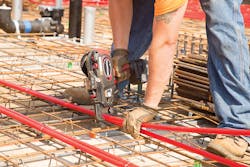ATLANTA, GA — In a Tuesday educational session, Bo DeAngelo of Viega and Lance MacNevin of the Plastic Pipe Institute joined forces to discuss the basics of hydronic snow melting; both the benefits, installation techniques, typical applications, control strategies and more. They were introduced by Les Nelson of the Radiant Professionals Association.
Editors note: Viega has developed many education and training options for its customers who want to learn more about radiant heating or hydronic snow melting, including full packages that include airfare, meals, accommodations and even entertainment, all at a reasonable price.
MacNevin began the session by remarking that he was originally from eastern Canada where it snows a LOT. He fell in love with hydronic snow melt systems early in his career. And why? Because of the clear benefits:
- Safety -- no one wants to break their hip slipping on snow or ice.
- Savings -- over the lifetime of a system, they are much more economical that removing snow by mechanical means such as shoveling or snowplows.
- Reduced liability -- if you have people walking past your business, their accident can easily become your problem.
- Reduction of harmful chemicals -- salt and other melting compounds are just not good for the environment.
- Access for aging population -- the Baby Boomers aren't getting any younger.
- Lower maintenance costs -- people get paid to shovel and plow.
- And yes, energy savings -- a well-designed system can be powered by high-efficiency boilers, geothermal loops, solar, heat pumps, or even make use of a building's waste heat.
And these systems are not new. MacNevin noted that there are some manuals from the 1950s and 1960s that use cast iron or copper pipe. While the materials have been updated -- modern systems use plastic pipe such as PEX, PE-RT or polypropylene -- the math involved in sizing and designing a snow melt system is still basically the same.
Installation Techniques
Surfaces for snow melt applications are typically either poured concrete, interlacing pavers or asphalt. Permiable concrete is probably the most difficult surface to work with.
For poured concrete, tubing is embedded 2" to 3" below the surface, close to the top where the heat can do the most good. Typically, the tubing is stapled to insulation board or tied to rebar or wire mesh prior to the concrete pour.
Some insulation boards have integrated "knobs" to help with the tubing spacing.
Below pavers, the tubing is installed using plastic rails, staples or screw clips. Tubing is encased in a sand bed with a depth of about 1.5". While it can take longer for pavers to heat up compared to a poured concrete application, once the sand gets wet thermal conductivity goes through the roof.
For asphalt, tubing is again installed above insulation. Keep in mind that the tubing must be filled with cold water during the asphalt pour to ensure the tubing does not melt.
Since insulation is a key component no matter the surface material, care should be taken to specify compacted, smooth earth before beginning an installation. This will ensure that the insulation is uniform, without buckles or gaps. Insulation is typically made from extruded polystyrene, expanded polystyrene or polyurethane.
Along with good insulation, any snow melt system requires adequate drainage; while some snow will get sublimated directly to steam, most flows away as water. Surfaces should be sloped for gravity drainage if possible. Be especially conscious of where the low points of the installation are -- and try to make sure no key components of the system (such as manifolds) are placed in areas which may flood.
Additionally, pipes, drains or gutters used for drainage may themselves require heat from the snow melt system in order to stay clear.
Distribution
The distribution system needs to be insulated as well. Pre-insulated PEX is the preferred method.
Consider how you will "relax" your distribution piping. Most of it comes much too stiff to simply roll out. Propane heaters can be used, if needed.
Wherever you may have building penetrations, they need to be waterproofed to prevent effluent from coming into the building. This particularly includes the mechanical room, as a flooded mechanical room can create no end of problems.
Manifold boxes must be insulated, and a good, durable, insulated manifold box can be surprisingly expensive. They are worth it all the same.
Applications
Possible applications for a hydronic snow melt system include (but are not limited to):
- Sidewalks
- Steps
- Pool decks
- Driveways
- Racetracks
- Walkways
- Roads
- Parking garages
- Train stations
- Hangers/aviation
- Melting "hotspots" -- these are places where snow is shoveled or plowed and then left to melt. An ideal solution for high-density areas (such as municipal parking) where snow melting the entire area is not practical.
Design
Melting snow and ice is a three-step process. First, warm to the melting temperature by applying 0.51 Btu/lb. Second, melt the snow and ice to cold water using 144 Btu/lb. Third, Evaporate the water or allow it to drain.
Several important factors, mostly based on geographical location and historical weather data, are involved in calculating how much thermal energy a system will require. They include:
- Air temperature
- Rate of snow fall
- Snow density
- Wind velocity
- (Apparent) sky temperature
After taking these factors into consideration, system design becomes a five-stage process:
- Set appropriate performance levels (this is the "Big Talk" you need to have with the client)
- Determine heat output
- Size and select the heat source
- Plan and layout the piping design
- Size and select the hydronics
When it comes to the all-important first step, setting the performance level, there are plenty of resources to help, perhaps the most important being ASHRAE HVAC Applications, "Chapter 51: Snow Melting and Freeze Protection."
Chapter 51 contains a table full of cities with data on their coldest/snowiest days, and with snowfall hours/year. While no two winters may be exactly alike (and while weather patterns are changing), the table can give designers a good guide to work from. For cities not included in the table, a nearby city can be selected. And if there is no nearby city, there are full instructions (with extensive formulas) for making your own calculations based on weather data.
Ultimately, the customer should get to choose what kind of snow melt performance they want. Chapter 51 gives numbers in Btu/sq. ft. for 75 percent of historic snowfall, 90 percent of historic snowfall, 95 percent, 98 percent, 99 percent and 100 percent.
100 percent means evaporating the snow as quickly as it falls so the surface is dry. This may require a lot more energy than the actual snow removal needs of the client. 100 percent systems tend to be over-built and can require a lot of thermal energy. But for applications such as, say, an emergency helipad, sometimes they ARE what the customer requires.
Control strategies
In general there are three basic control strategies:
On/off - each start is a cold start. They can be operated manually, or hooked to a sensor and operated automatically.
Idle/melt - This reduces response time, in that it is hot when there is snow, but the system does not power down completely. This consumes more energy in return for a more rapid response.
Always on - The system is in constant operation, or possibly seasonal operation. Turn it on in October, turn it off in April. Obviously more expensive if you are paying for your Btus. But for, say, a factory that is simply dumping its waste heat, this can be a good option.
Predictive "smart" controls tied directly to weather data can be used with most systems to help improve efficiency.
Various moisture/temperature sensors are available, but they need to be placed correctly to do the system the most good. If a car can park over the sensor, that is NOT a good location. They should be located in the first place snow will fall and the last place to get cleared.
Savings
It is fairly simple to predict annual operating costs, although keep in mind each winter is different. While upfront costs to install a hydronic snow melt system can be steep, over the life of the system they are much more affordable that snow plows, workers to shovel, or salt.
About the Author
Steve Spaulding
Editor-in-Chief - CONTRACTOR
Steve Spaulding is Editor-in-Chief for CONTRACTOR Magazine. He has been with the magazine since 1996, and has contributed to Radiant Living, NATE Magazine, and other Endeavor Media properties.

